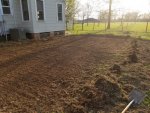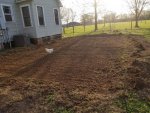Hello TFP,
I have an intex 16x32 ultraframe on the way. I have been doing my "due diligence" (read obsessive researching) on this process. Here is the 1000 foot view in my head:
1) Determine grade with stakes, masonry string and bubble level
2) Use large tiller to tear up a 18'x34' area to account for blocks under legs
3) rake the now loosened dirt from the high side of grade to the low side(our area is pretty flat here in South Louisiana) but there is a bit of a concave to fill in
4) Tamp the now raked dirt and scrape with long 2x4 and tamp some more
5) Place the 16 foam sheets and duck tape the seems, including additional tape in the corners
6) Place the tarp that comes with the pool on top of the foam
7) layout the rail to show me where the legs will be
8) dig down and install 16"x16"x2" blocks butted up against the foam boards and dug down to be flush with the foam boards
9) Layout the liner
10) install rail and legs
11) Begin filling and removing wrinkles
I will also be installing a through wall skimmer and hard plumbing the filter and SWG, bu those will have their own list when we get to that step
Any feedback is much appreciated
I have an intex 16x32 ultraframe on the way. I have been doing my "due diligence" (read obsessive researching) on this process. Here is the 1000 foot view in my head:
1) Determine grade with stakes, masonry string and bubble level
2) Use large tiller to tear up a 18'x34' area to account for blocks under legs
3) rake the now loosened dirt from the high side of grade to the low side(our area is pretty flat here in South Louisiana) but there is a bit of a concave to fill in
4) Tamp the now raked dirt and scrape with long 2x4 and tamp some more
5) Place the 16 foam sheets and duck tape the seems, including additional tape in the corners
6) Place the tarp that comes with the pool on top of the foam
7) layout the rail to show me where the legs will be
8) dig down and install 16"x16"x2" blocks butted up against the foam boards and dug down to be flush with the foam boards
9) Layout the liner
10) install rail and legs
11) Begin filling and removing wrinkles
I will also be installing a through wall skimmer and hard plumbing the filter and SWG, bu those will have their own list when we get to that step
Any feedback is much appreciated


 Item 12 (ADDED) - Tylenol!
Item 12 (ADDED) - Tylenol! 
